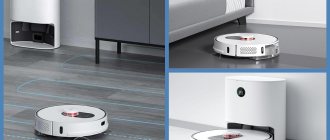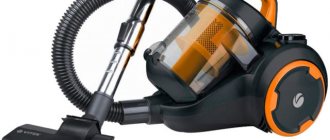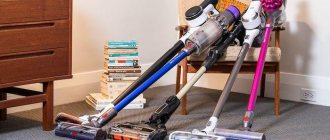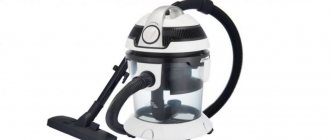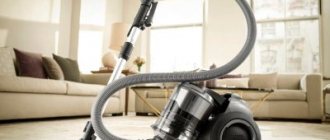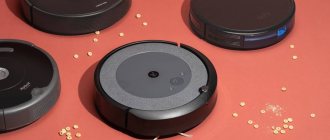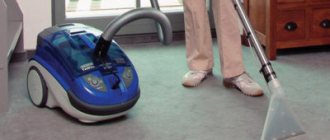Greetings to all readers of the Robotobzor site! Today I will tell you about the most useful functions that modern robotic vacuum cleaners can be equipped with. The fact is that when choosing a suitable model, many find it difficult to choose the functionality that will be useful specifically in your conditions. And overpaying for useless options is not at all rational, especially since only expensive premium robot vacuum cleaners have advanced capabilities. Next, we will look at the 10 most useful functions and the conditions in which they will really be needed.
Robot vacuum cleaner
Already from the name of this device you can understand that almost all processes in it are automated. The robot vacuum cleaner cleans the house without human help. Basically, all you need to do to get started is turn on this smart appliance and start the cleaning program. It should also be noted that such smart devices can clean even a room furnished with furniture. The type of flooring does not play a significant role.
Today on sale you can find models that can not only vacuum clean, but also wash the floor, while carefully “circling” places where there is carpeting, etc. By the way, the process of operating a robot vacuum cleaner is almost silent.
Karcher robot vacuum cleaner cleans the house without human help
Remote control
But this function is relevant for robotic vacuum cleaners of different prices. Now everyone is chasing control through a branded mobile application, but it is not always appropriate. Especially when it comes to buying a robot vacuum cleaner for elderly relatives or for cleaning at sites where there is simply no Wi-Fi.
V55 Pro and remote
So in this case, models that are controlled only from a smartphone are deprived of almost all of their capabilities. As a rule, on the case there is only a Start/Pause and return to base button, and all the treasured functions, for which you overpaid, remain only in the application. The presence of additional control from the remote control will be very useful in this case and will allow you to get out of the situation when you cannot control your smartphone.
Types of devices
There are 3 types of such devices:
- dust suction device;
- washing robot vacuum cleaner;
- robot plotters - carry out dry and wet cleaning using microfiber cloths.
The more functions such a device has, the higher its price.
Washing robot vacuum cleaner iRobot Scooba 385
Appearance
Externally, the robot vacuum cleaner looks like a small disk, or less often a rectangle. The diameter of such a structure is no more than 30 centimeters, the height is 3 times less. Due to this shape, the device can penetrate even hard-to-reach places.
The smart robot vacuum cleaner moves using three wheels with a rubberized base. The entire system is driven by a built-in electric motor.
The control panel is usually located at the top. Newer and more expensive models have a touch control panel that is protected from moisture and dust. Overall, the design of this vacuum cleaner is attractive. How does a robot vacuum cleaner work? Let's take a closer look at each type of such device.
Robot vacuum cleaner Samsung Navibot S Pop-Out
Robot vacuum cleaner for dry cleaning
Devices of this type were the very first to appear on the smart technology market. The operating principle of a robot vacuum cleaner is very similar to its wired counterpart. Dirt and dust are also captured by a brush or similar structural element. The dirt collected in this way enters the bag or container with the help of an air flow, settling safely there. At the end of cleaning, identical to a conventional vacuum cleaner, the container or bag is simply shaken out. It should be noted that the first such models were not much smaller than the usual models of vacuum cleaners that many of us use.
As for the dust collector, there are only 2 types of them - a bag and a plastic container. A plastic container can last much longer than a bag. But it is a little more difficult to clean. However, device models with a plastic container have replaceable filters. So you can just throw it away and not have to worry about cleaning it.
When choosing a robot vacuum cleaner model, you need to consider the capacity of the dust collector. The intensity of house cleaning will depend on this. As a rule, if you choose a device with a plastic container, a set of replacement filters is included.
Roomba 776, robot vacuum cleaner for dry cleaning
Cleaning system
Most robot vacuum cleaners are designed for a 3-stage cleaning system:
1st stage
End brushes sweep up debris along the suction opening, expanding the coverage of the working area, speeding up cleaning and improving its quality. Another task of end brushes is to collect dirt lying near baseboards or in corners. Some manufacturers compensate for the functionality of side brushes with a D-shaped body and a working unit width of up to 300 mm. The most striking representatives of this design are the iRobot Roomba s9 or Neato Botvac D7 Connected, which demonstrate high quality cleaning using a single side brush. There are alternative solutions that completely replace side brushes. For example, the Samsung VR7070WD uses a paddle that falls out of the working unit to clean wall areas.
2nd stage
The central brush performs contact treatment of the surface. The nature of the treatment performed depends on the type of brush:
- A classic turbo brush with V-shaped nylon bristles: combs out wool and hair from carpets, picks up crumbs stuck between the fibers, and removes sand from tile joints and cracks in parquet. The main disadvantage of this accessory is that it gets heavily clogged with hair, which is why the fluffy turbo brush has to be cleaned after each working cycle.
- A brush with silicone petals: scrapes dried-on dirt from hard floors, is much less likely to become clogged with hair, but is almost useless on carpets. An additional function of the silicone brush is that it increases the air flow in the suction channel.
- Petal-bristle turbo brush: a universal accessory that is suitable for processing any coating, but requires periodic maintenance.
- Rubber roller with a deep tread: collects hair well, removes dirt stuck to the floor and does not get clogged with hair. To improve the quality of cleaning, some manufacturers equip their vacuum cleaners with two such rollers at once (iRobot Roomba 980 or).
Robots without a turbo brush also do a good job of cleaning hard surfaces. Their main advantage is ease of maintenance: hair does not cling to the bristles and is not wound around the brush axis, but is immediately sent to the dust collector.
Reference! Hybrid robotic vacuum cleaners, such as Ecovacs Deebot ozmo 930 or Clever & Clean AQUA–Series, are equipped with replaceable working units: direct suction and with a turbo brush.
3rd stage
The impeller of the electric motor creates a vacuum under the bottom of the robot, which draws sand, dust and wool that fall onto the turbo brush (or under the suction channel) into the dust collector. To process linoleum, tiles or laminate, in most cases, a motor with a suction force of up to 1000-1200 Pa is sufficient; to extract dust and sand from carpets, you will need a more powerful vacuum cleaner - at least 1500-2000 Pa.
The collected debris ends up in a cyclone-type dust collector, where it is retained by a filter system. Advanced air filtration includes 3 types of filters:
- fine mesh – holds large debris and wool;
- foam padding – prevents fine dust from flying out;
- pleated HEPA filter - prevents microscopic dirt, allergens and mold spores from flying out of the container.
In devices with a module for wet cleaning, a fourth step is added to the above three stages of dry cleaning - wiping the floor with a damp cloth. Typically this function is implemented as follows:
- a special container with a water tank and a rag holder is inserted under the bottom or in place of the dust collector;
- pre-moistened microfiber is installed on the Velcro holder;
- the robot vacuums the floor and then removes the remaining dust with a cloth, which is kept moist by water coming from the built-in reservoir.
Some models, such as the Okami U100, have a special operating mode for wet cleaning - reciprocating passages that imitate the movements of a mop. Other robots (for example, Hobot Legee 688), instead of a traditional module for wet cleaning, are equipped with vibrating mops, which allow not only removing surface dust from the floor, but scrubbing traces of pets or removing old stains.
A separate class of devices is represented by robot floor polishers, designed exclusively for wet cleaning. The most typical example is the iLife W400, which wets the floor as it moves, wipes away the soaked dirt with a roller and sucks dirty water into a separate container.
Robot vacuum cleaner for wet cleaning
In this case, there are 2 types of devices: one works on the principle of a plotter, and the other carries out step-by-step cleaning. The robot vacuum cleaner operates on the plotter principle using a special microfiber cloth. The rag itself is attached to the nozzle, after which cleaning is carried out with water and detergent liquid, which is located in the middle. Essentially, this is the same as washing the floor with a regular mop, but the process is fully automated.
As for the step-by-step robot vacuum cleaner, everything is somewhat more complicated. First, the device sprays liquid over the contaminated surface. Next, using special brushes, the area is intensively rubbed. At the end of this stage, the soaked dirt is simply sucked into a special container. At the final stage, the robot vacuum cleaner removes remaining moisture using a rubber or silicone scraper. The end result is a completely clean and dry surface. Water along with washing liquid is in a special tank, which is made of impact-resistant plastic. As for the collection of dirt and water, only a plastic container with replaceable filters is used here.
Comparing these two subtypes of “smart” home appliances, we can say that the step-by-step model of the device performs cleaning much better.
Robot vacuum cleaner Panda X900 Wet Clean with water
Robot plotter
You can also find a mixed-type robot vacuum cleaner on sale. It carries out both dry and wet cleaning. However, it should be noted that this type of home equipment is not very suitable for allergy sufferers. This robot cleans using a rag or microfiber cloth. Also, a model of this type will not clean absolutely the entire floor covering. Preference is given to the following flooring material:
- tiles;
- laminate;
- linoleum;
- varnished parquet.
As for carpet material, there are limitations - this type of automated equipment will not clean material with a pile longer than 3-4 millimeters.
Overall, this stand-alone vacuum cleaner is perfect for office spaces or apartments without carpet. Since it can carry out both dry and wet cleaning, which significantly reduces the overall cleaning time.
Moneual robot plotter for dry and wet cleaning
Self-cleaning at base
No matter what anyone says, self-cleaning robot vacuum cleaners are really convenient and another big step towards automatically keeping the house clean. So robots with a self-cleaning base are an excellent solution if you are put off by the need to clean the dust collector every few cleaning cycles.
Self-cleaning
By the way, a washing robot vacuum cleaner has already appeared on the market, which self-cleans on the base, and in addition, independently rinses napkins and dries them after the cleaning cycle. The model is called Narwal T10 and we hope that this robot will soon appear on the Russian market.
Device diagram
Despite the fact that models of such cleaning equipment may differ in their functions, the scheme is almost the same. Most automated vacuum cleaners are assembled from the following components:
- battery;
- module with brushes;
- module with wheels;
- container for collecting garbage and dust;
- liquid reservoir (if it is a washing vacuum cleaner);
- paddle brush;
- housings;
- removable top panel.
Also included is always a charger for the robot.
How to choose: criteria and characteristics
To make using a robot vacuum cleaner truly comfortable, you need to pay attention to its technical characteristics before purchasing.
Before choosing a device that really suits you, let's decide on all the important characteristics.
Container volume
To clean rooms that occupy a small area, devices with a dust collector holding 0.3-0.4 liters are suitable. To clean larger homes, devices with 0.5 liter containers are useful.
Noise level
Noise of 50 dB and above can cause significant discomfort, especially at night. To ensure that the vacuum cleaner does not interfere with your rest, the noise level during its operation should not exceed 36 dB.
Navigation type
For a good robot vacuum cleaner to work, the user practically does not have to make any effort. It is recommended to give preference to devices that can independently navigate the surrounding space, create a map of the room being cleaned, and easily overcome obstacles. Such options are especially important for houses and apartments with many rooms.
A navigation system is included in every robot vacuum cleaner. It can consist of three types of sensors:
- ultrasonic – allow the gadget to easily move under and out of furniture, detect doorways and move on to cleaning the next room;
- optical – necessary for identifying obstacles and avoiding collisions with them;
- infrared - thanks to them, the vacuum cleaner senses changes in height: it passes through wires without getting tangled in them, does not fall down stairs, and does not drive onto carpets.
There is another classification of navigation systems:
- Contactless. The device detects obstacles at a distance and, in order to avoid colliding with them, corrects the direction of movement. The device can move along different trajectories: straight, in circles or zigzags.
- Contactless. When it collides with an object, it begins to move in the opposite direction. Such models are additionally equipped with a soft bumper.
Suction power
Conventional models have a suction power of no more than 20-22 W. More expensive robots boast 30 to 35 watts of power. This is enough to remove small debris and dust.
Battery type and capacity
Modern robot vacuum cleaners operate on three types of batteries:
- Li-Ion. A device with such a battery can cope with cleaning a large area in a short period of time.
- Li-Pol. High quality polymers are used in the manufacture of Li-Pol batteries. ensuring long service life of the device. They contain no flammable components.
- Ni-MH. Can withstand 20% more charge cycles than lithium-ion. The disadvantage is the high discharge rate and heating during operation, which can be dangerous.
Number of filtration stages
By sucking in air, the device passes it through filters that trap dust and debris. The quality of cleaning and the absence of re-contamination directly depends on the cleaning system.
There are two types of filters:
- rough cleaning - an economical option that retains large debris, but does not protect against dust emissions;
- HEPA filter - has a compacted structure and a large number of layers that prevent dust from entering the air.
Equipment
The main device must be supplemented with the following components:
- power adapter;
- instructions for using the device;
- charging base;
- warranty card.
It is advisable that the kit include spare brushes and filters, limiters and motion coordinators.
Important! You need to pay attention. Does the vacuum cleaner come with a remote control?
Robot height
On average, the height of a robotic vacuum cleaner is 6-10 cm, but on sale you can find models whose height is only 3 cm.
Movement in space
The way such a home assistant carries out cleaning is understandable. But by what principle does he “drive” around the house, and how does he recognize obstacles in his path? The robot vacuum cleaner navigates in space using one of the following technologies:
- laser rangefinder;
- ultrasonic rangefinder;
- according to the “virtual wall” principle;
- contact sensor;
- infrared sensor.
An ultrasonic rangefinder measures the distance between an object that is in the path of the vacuum cleaner and the equipment itself, transmitting the data to the robot. Thus, the smart home assistant does not crash into furniture or walls.
The robot vacuum cleaner uses an ultrasonic rangefinder to measure the distance between objects
As for the laser rangefinder, it simply scans the space and forms a kind of “map” for the operation of the vacuum cleaner itself. In addition to the fact that this way the equipment will not crash into objects, cleaning is carried out more efficiently and quickly.
Models with a contact sensor work on a completely different principle. There are special sensors along the edges of the vacuum cleaner. When they come into contact with an object, they send a signal to the robot, and it simply goes around the obstacle.
The virtual wall allows you to set restrictions on the operation of equipment. This limiter works using an infrared sensor. For example, if you want cleaning to be carried out only in one specific room, models with this function will be very useful.
The virtual wall allows you to set restrictions on the operation of the robot vacuum cleaner
Models with an infrared sensor will be relevant in rooms with stairs. It is this function that prevents the robot from falling from a height while cleaning. Also, some models have a special cleaning algorithm that can be adjusted by the user. Additional sensors can carefully scan the area for particularly dirty areas. The vacuum cleaner will clean such places longer and more intensively.
Modern models have an additional system for recognizing difficult areas. For example, if the robot gets tangled in wires while cleaning, the functioning of the entire system will stop until the device moves away from the dangerous area. Also, such models have a special sensor to recognize the type of surface. Thus, cleaning will be carried out as carefully and efficiently as possible.
Saving multiple cleaning maps
If you have a two or three-story house, then consider purchasing a robot vacuum cleaner that can store several maps in its memory.
Multi floor plan
Thanks to this opportunity, when moving the robot from floor to floor, it will not need to re-acquaint itself with the floor and build a map of the room. Cleaning will be done faster and better. This feature is also called multimap support and so far it is supported only by premium robots.
Cleaning schedule
Models even in the mid-price category have an important function - the user can set a cleaning schedule. At the right time, the robot will automatically activate and begin cleaning the house. Some models have an additional remote control.
When the device's charge is running low, the system automatically directs the robot to the charger. Using special sensors, the vacuum cleaner itself finds the connection location. When charging is complete, it can automatically continue working.
The robot vacuum cleaner finds the charger itself
